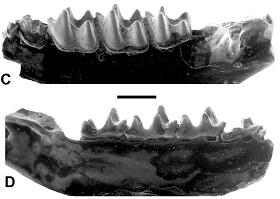Using AI to control energy for indoor agriculture
30 September 2024
Published online 14 February 2014

Fossils found in the Egyptian desert have given scientists an insight about the origins of Madagascar's sucker-footed bats. The excavated jawbones of two extinct species link the strange island bat families evolutionarily to the African continent for the first time.
The two types of sucker-footed bats, Myzopoda aurita and Myzopoda schliemanni are both native to Madagascar, living on opposite sides of the island. Myzopodids have long puzzled scientists for their differences from other bat species. They don't hang upside down or live in caves, but roost upright inside palm tree leaves using distinctive adhesive pads around their bodies. They are also apparently free of parasites and among the eastern-dwelling group, Myzopoda aurita, researchers are yet to find a female of the species, yet evidence of young bats is easy to see.
The fossils, discovered in the Fayum Depression in northern Egypt, come from two extinct species Phasmatonycteris phiomensis and Phasmatonycteris butleri, and scientists say they are related to the Madagascar bats. "We will no longer think of this family as small and relegated to Madagascar, now it will be perceived as an African group," says co-author Nancy Simmons, mammalogy curator at the American Museum of Natural History.
Prior to the discovery, scientists were only able to estimate the Myzopodids origins through molecular phylogenetic analysis, but the Egyptian fossils increase their geographical and temporal ranges by 4,000 kilometres and 37 million years respectively. "Madagascar's mammal fauna is largely made up of African immigrants that managed to disperse across the Mozambique Channel at different times", adds co-author Erik Seiffert.
The discovery bolsters the present understanding of bats, says Paul Racey, a biologist at the University of Exeter. "The evolutionary history of bats, for which this paper provides evidence, mirrors that of marsupials which are found in both new and old worlds."
Once these plants and animals are gone, they're gone for good - there is no going back.
Based on DNA evidence, Myzopodids are distantly related to the Noctilionoidea family of bats in South America. A paleontologist at Duke University, Gregg Gunnell, who co-authored the research, suggests that the South American group originated in Africa more than 37 million years ago. Fossils of the next most distant relative, the Mystacinidae (now only found in New Zealand), show it lived in Australia 26 million years ago. All those different families may find their origin in the extinct Phasmatonycteris phiomensis and Phasmatonycteris butleri.
"We can construct a scenario whereby the earliest members of Noctilionoidea arise in Africa 40 million years ago or more, make their way to Australia following prevailing ocean currents, then into Antarctica and on to South America around 26 million years ago," explains Gunnell. "This is just a scenario but it does fit with known evidence."
Gareth Jones, a bat ecology specialist at the University of Bristol, offers another explanation to the worldwide distribution of the sucker-footed bats' relatives. "A spread out of Africa into the southern ancient supercontinent of Gondwana, and then on to South America and New Zealand makes perfect sense in understanding the distribution of Myzopoda's relatives today.
"These new findings show similar parallels in that the origin, isolation and spread of lineages make sense in terms of how the continents drifted in deep time."
The researchers will continue looking for connections between bats in Madagascar, Africa and the rest of the world, however, Gunnell explains, Malagasy wildlife and nature are threatened by "rapid habitat destruction by humans".
"Madagascar is unique in every way and once these plants and animals are gone, they're gone for good - there is no going back," he says. He hopes the research can help reinforce the scientific significance of the island "before it's too late".
doi:10.1038/nmiddleeast.2014.47
Stay connected: